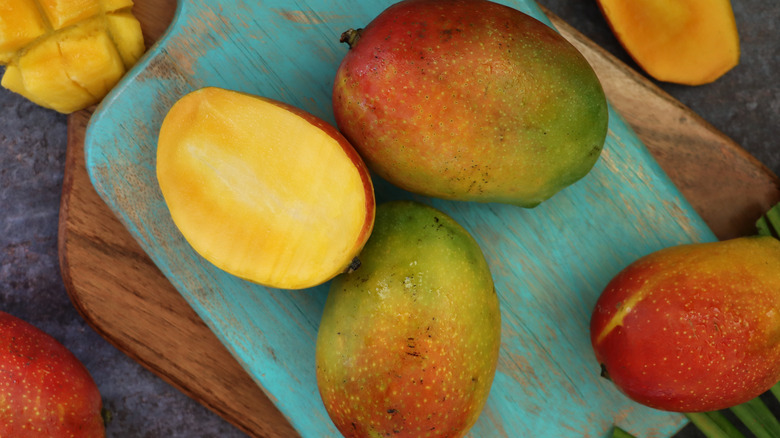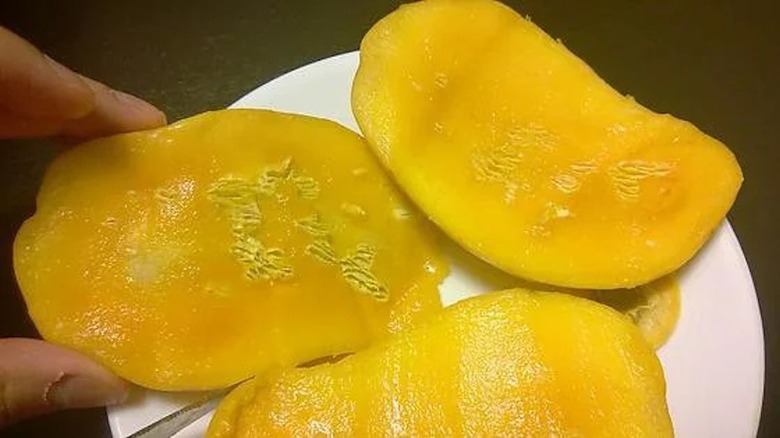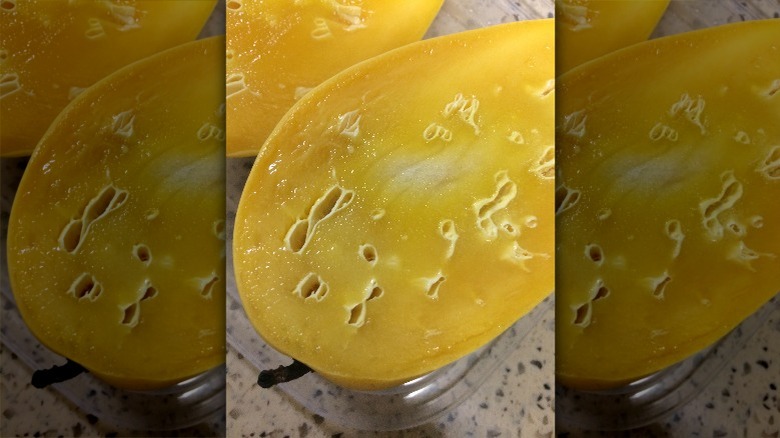The White Pockets Inside Mangoes Are Safe To Eat - But There's A Catch
Picking and choosing the right mango requires some skill. Unlike many other fruits, color is rarely the best indicator of good quality mango. Mangoes come in shades ranging from red, yellow, orange, and sometimes even green, so the best way to find out whether a mango is ready for the taking is to touch and gently squeeze it. If a mango feels too stiff, it could probably do with a bit more time to ripen. On the other hand, if it feels too soft and squishy with skin that's starting to shrivel up, chances are the mango's flesh is going to be brown and rotten.
Unfortunately, mango can be a finicky fruit, and much like an avocado, you won't really know what's going on inside until you slice it open. No matter how much you feel a mango for its ripeness, there can still be unexpected surprises waiting inside — most notoriously, white pockets dotting the otherwise juicy golden-yellow flesh. However, unlike the brownish black mushy patches, these white pockets of air are not a sign of overripeness or a mango gone bad. The good news is, mangoes with these white holes are perfectly safe to eat. But there is a catch: The pockets affect the mango's flavor rather than its freshness, and are a sign of a fruit that's going to be a touch subpar in taste.
What causes white pockets in mangoes
The white spots of air inside a mango may be unappetizing to look at, but they're certainly not an indicator of a rotten or overripe fruit. Rather, these white spots form when mangoes undergo a necessary step during harvest. The biggest problem when growing mangoes is the threat of fruit fly infestations. Mango fruit flies are considered to be the most damaging pest in India — where nearly half of the world's mangoes are grown — and it reportedly destroys 27% of the country's harvest each year. To protect mangoes from fruit fly infestation, they are soaked in water that's hot enough to kill any larvae or fruit fly eggs.
While the bath is a necessary step to protect the mangoes, it can also lead to a side effect — the starchy white patches in question. The white pockets inside mangoes are patches of starch that never turned into sugar because they were exposed to hot water too soon. This generally happens when the mangoes have been plucked too early. If a mango isn't mature enough, the hot water will increase its metabolism but hinder it from taking in any oxygen, causing it to ferment rather than ripen properly. These immature mangoes then start to generate carbon dioxide and alcohol which, trapped within the mango's skin, form edible white pockets inside the mango's flesh.
Edible but not delicious
Since soaking immature mangoes also prevents them from ripening properly, white patches are also a sign of a fruit that will never quite reach the sweet, floral, and creamy flavor potential that makes a perfectly ripe mango delicious.
So, while it's perfectly safe to consume a mango with white pockets, it may not be particularly pleasant to eat. You could, of course, avoid the white spots altogether and simply nibble on the yellow flesh around it, but even then, the flavor of the mango may leave much to be desired. In this case, it may be better to use the mango for preparations where it can be tossed with other ingredients rather than being eaten by itself.
Because the white patches are made from starch that wasn't converted to sugar, it may be a good idea to use the mango in savory preparations where its lack of sweet flavor will not be missed. Consider saving mango with white pockets for say, a fresh salsa with onions, bell peppers, cilantro, and lime juice, or add it to a cowboy caviar with beans, peas, and corn. You could also pair the mango with chili, blend it into spicy margaritas. The key is to use it in any recipe where the white-dotted mango's not-so-sweet flavor can be used to its advantage.



